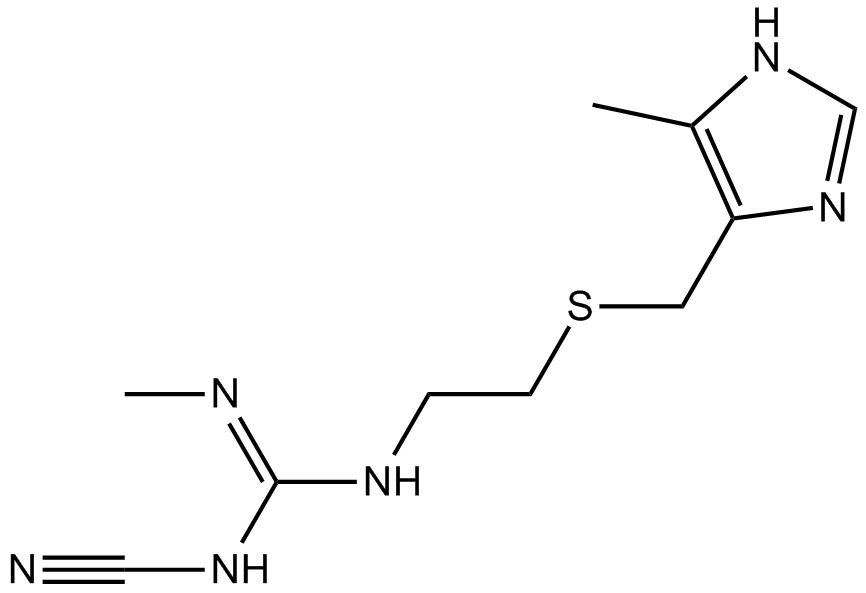Cimetidine (Synonyms: NSC 335308, SKF 92334) |
| Catalog No.GC13486 |
H2 receptor antagonist
Products are for research use only. Not for human use. We do not sell to patients.

Cas No.: 51481-61-9
Sample solution is provided at 25 µL, 10mM.
Cimetidine is a histamine-2 (H2) receptor antagonist.IC50 Value: Target: Histamine-2 Receptorin vitro: Cimetidine, a partial agonist for H2R, has a pharmacological profile different from ranitidine and famotidine, possibly contributing to its antitumor activity on gastrointestinal cancers [1]. Cimetidine had no effect on the uptake and cytotoxicity of cisplatin in ovarian cancer cells with high OCT2 mRNA levels (IGROV-1 cells) [2]. Cimetidine showed no effect on proliferation, survival, migration and invasion of 3LL cells. Cimetidine reversed MDSC-mediated T-cell suppression, and improved IFN-γ production. [3]. Cimetidine-mediated down-regulation of NCAM involved suppression of the nuclear translocation of NF-kappaB, a transcriptional activator of NCAM gene expression [4].in vivo: the antitumor efficacy of cisplatin in mice bearing luciferase-tagged IGROV-1 xenografts was unaffected by cimetidine (P = 0.39). Data obtained in 18 patients receiving cisplatin (100 mg/m(2)) in a randomized crossover fashion with or without cimetidine (800 mg × 2) revealed that cimetidine did not alter exposure to unbound cisplatin [2]. cimetidine reduced CD11b(+)Gr-1(+) myeloid derived-suppressive cell (MDSC) accumulation in spleen, blood and tumor tissue of tumor-bearing mice [3]. Cimetidine exerts a beneficial effect on periodontal disease in rats, decreasing the RANKL/OPG ratio in gingival connective tissue and reducing alveolar bone resorption [5].
References:
[1]. Takahashi, H.K., et al., Cimetidine induces interleukin-18 production through H2-agonist activity in monocytes. Mol Pharmacol, 2006. 70(2): p. 450-3.
[2]. Sprowl, J.A., et al., Conjunctive therapy of cisplatin with the OCT2 inhibitor cimetidine: influence on antitumor efficacy and systemic clearance. Clin Pharmacol Ther, 2013. 94(5): p. 585-92.
[3]. Zheng, Y., et al., Cimetidine suppresses lung tumor growth in mice through proapoptosis of myeloid-derived suppressor cells. Mol Immunol, 2013. 54(1): p. 74-83.
[4]. Fukuda, M., K. Kusama, and H. Sakashita, Cimetidine inhibits salivary gland tumor cell adhesion to neural cells and induces apoptosis by blocking NCAM expression. BMC Cancer, 2008. 8: p. 376.
[5]. Longhini, R., et al., Cimetidine Reduces the Alveolar Bone Loss in Induced Periodontitis in Rat Molars. J Periodontol, 2013.
Average Rating: 5 (Based on Reviews and 37 reference(s) in Google Scholar.)
GLPBIO products are for RESEARCH USE ONLY. Please make sure your review or question is research based.
Required fields are marked with *




















